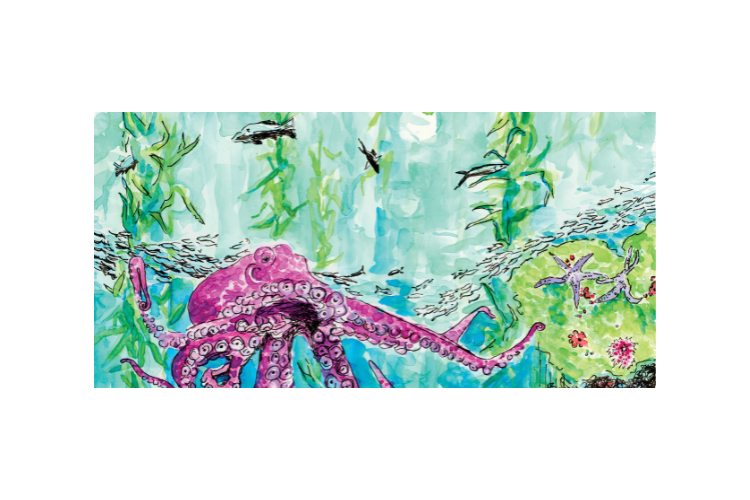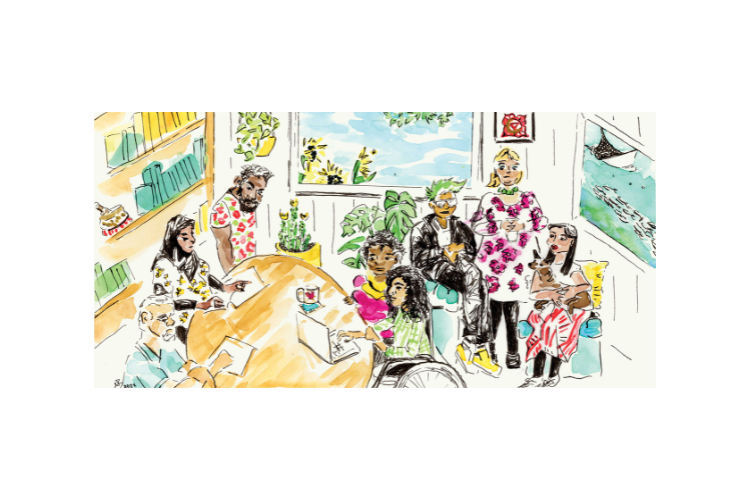Artist Statement, Vanessa Rae
Series for Stacie Freasier – c3 Catalyst (2022)
This is a series of four interrelated paintings: Diverse Workplace, Kelp Forest, Coral Reef, and Gulf Coast Birds.
Both vital and fragile, these vibrant ocean-related ecosystems reflect our own existence in the micro-ecosystems of work and community as well as in the macro-ecosystem of this world. Wild diversity is one of nature’s strategies for long-term sustainability and success. Nature has its own systems so that diverse participants thrive in an environment, including moments of transformation. The participants and the environment change each other as they interact. And so do we.
Vanessa Rae is an artist who has traveled to many parts of the world to bear witness and advance human rights and sustainability. She now lives in the woods of Michigan, where she tends her gardens and feeds the birds. She works in simple, direct media: watercolor, ink, and hand-cut block prints. She creates images related to slow food, spiritual questing, and wild grace.
There are prints available online at VanessaRaeArtStudio. Sales of Gulf Coast Birds benefit Friends of Padre which organizes the annual beach clean-up on a remote part of Padre Island National Seashore.
Thank you for engaging with her work. 🦋
###
Community Cultivation
Title: Kelp Forest
In the kelp forest, the venerable octopus lives in community with sea urchins, sea stars, and a wide range of fish. For many fish and mammals, kelp forests provide literal shelter in the storm. Teeming with tiny life, they also provide food for birds including gulls, crows, great blue herons, and cormorants. These underwater forests absorb massive amounts of carbon dioxide and protect shorelines from erosion: “They are a green belt that connects us all.” (Future Ecologies) This painting and write-up provide only a glimpse of the complex ecosystems of the kelp forests and their role in planetary survival. They are a beautiful illustration of how we are all interconnected, and they need our attention and conservation efforts.
Please listen to the Future Ecologies podcast, episode trio Kelp Worlds to learn more.
Creative Collaboration
Title: Diverse Workplace
Created to reflect Stacie Freasier’s vision for a diverse, mindfully collaborative workplace.
This piece includes:
root chakra wall art to invoke grounding and decision making that ensures everyone’s basic security and well-being.
blooming fairy castle cactus Acanthocereus tetragonus to honor life that thrives even in the deserts like those in Texas.
sunflowers being visited by bees – sunflowers now linked to the resistance by the people of Ukraine to the Russian invasion, and bees because bees. Pollinators ensure our lives go on, so we must ensure their lives go on; and
a painting of a ray and schooling fish, leading you into the water worlds that follow.
Context Centering
Title: Coral Reef
Behold! The peacock mantis shrimp. Though they probably saw you first: these critters have outstanding eyesight. They can see more wavelengths of color than we can, so they look even fancier to each other than they do to us. Also known as the harlequin, rainbow, or clown mantis shrimp, Odontodactylus scyllarus lives in the burrows they dig in the base of coral reefs. They are here to represent seeing the unseen and the capacity for extraordinary vision.
Their home, the coral reef, is one of the most complex and vulnerable ecosystems on earth. Coral reefs provide habitat for about a quarter of marine life. When a coral reef is thriving, it resembles a colorful, fantastical city full of unique characters playing out their specific roles. Understanding how their roles are interrelated to the whole is part of how we improve the chances of the reefs and their residents thriving.
Understanding how human life and industry impacts reef life is critical to protecting these intricate ecosystems. Coral reefs are collapsing under damage from pollution and bleaching resulting from climate change, and they too require our attention and conservation.
Please see David Attenbourough’s Life in Color Netflix series, episode Seeing in Color to learn more about the peacock mantis shrimp.
To learn more about the mysterious and essential ocean, please listen to Allie Ward’s Ologies podcast, episode Oceanology.
Contact Page
Title: Gulf Coast Birds
To honor the coastal life of Texas, this painting is a portrait of some of the birds who rely on the wetlands of the Gulf Coast, including painted bunting, roseate spoonbills, white American pelicans, and whooping cranes.
Birds hold mystical meaning and sacred importance for people across the world and through time. They enchant us with colors and songs; they offer us the up-lifting inspiration of flying, requiring nothing but their bodies—some tiny, some of prehistoric proportion, like the pelican—of incredible design.
Habitat loss and climate change have already wiped out entire species of birds; many more are vulnerable. Precious few whooping cranes remain. Some of them winter in the Texas Coastal Bend (where Stacie was born), and Aransas, TX has held a Whooping Crane Festival in their honor since 1996.
Please listen to The Gulf podcast, episode “A Sense of place” to learn more about Padre Island National Seashore.




